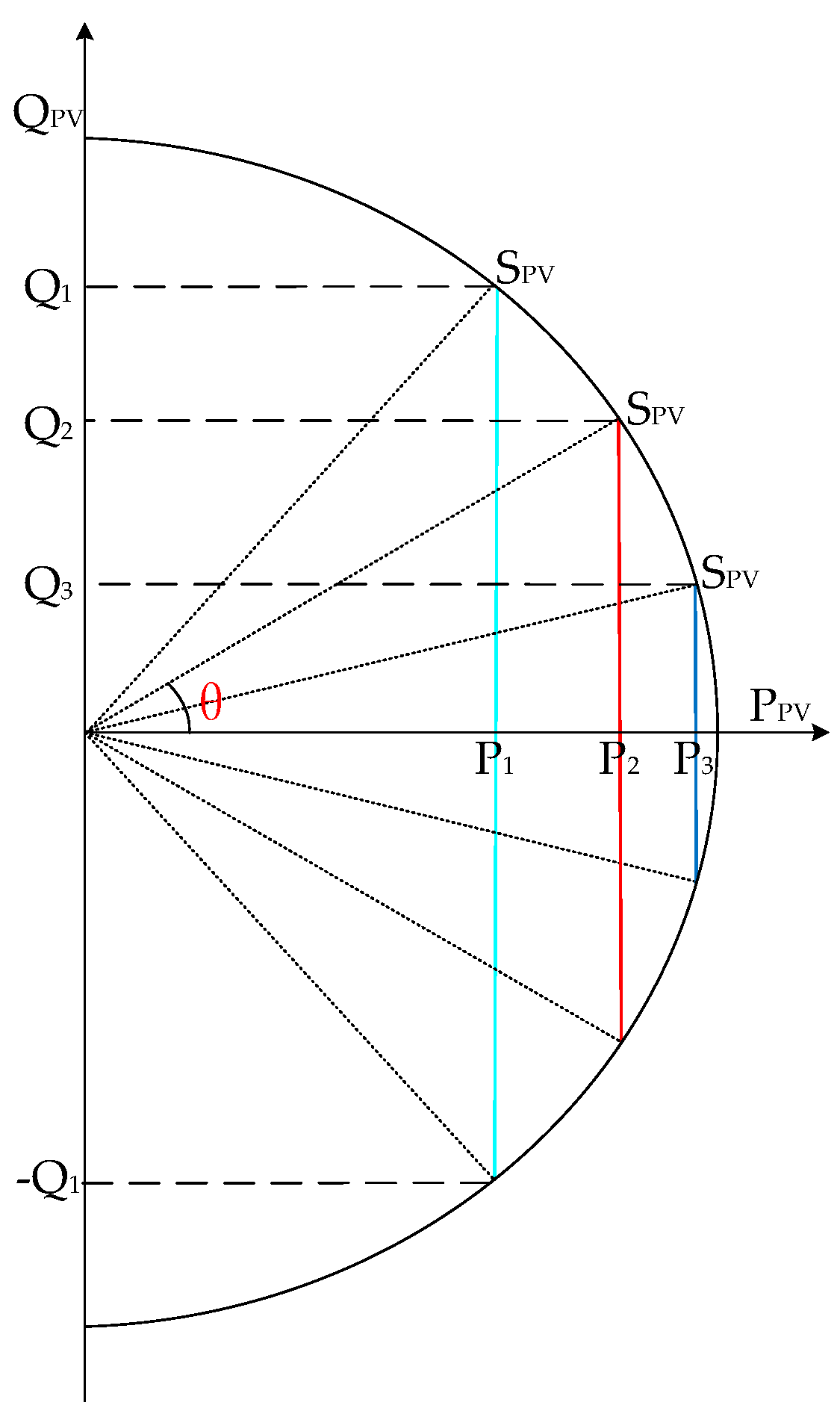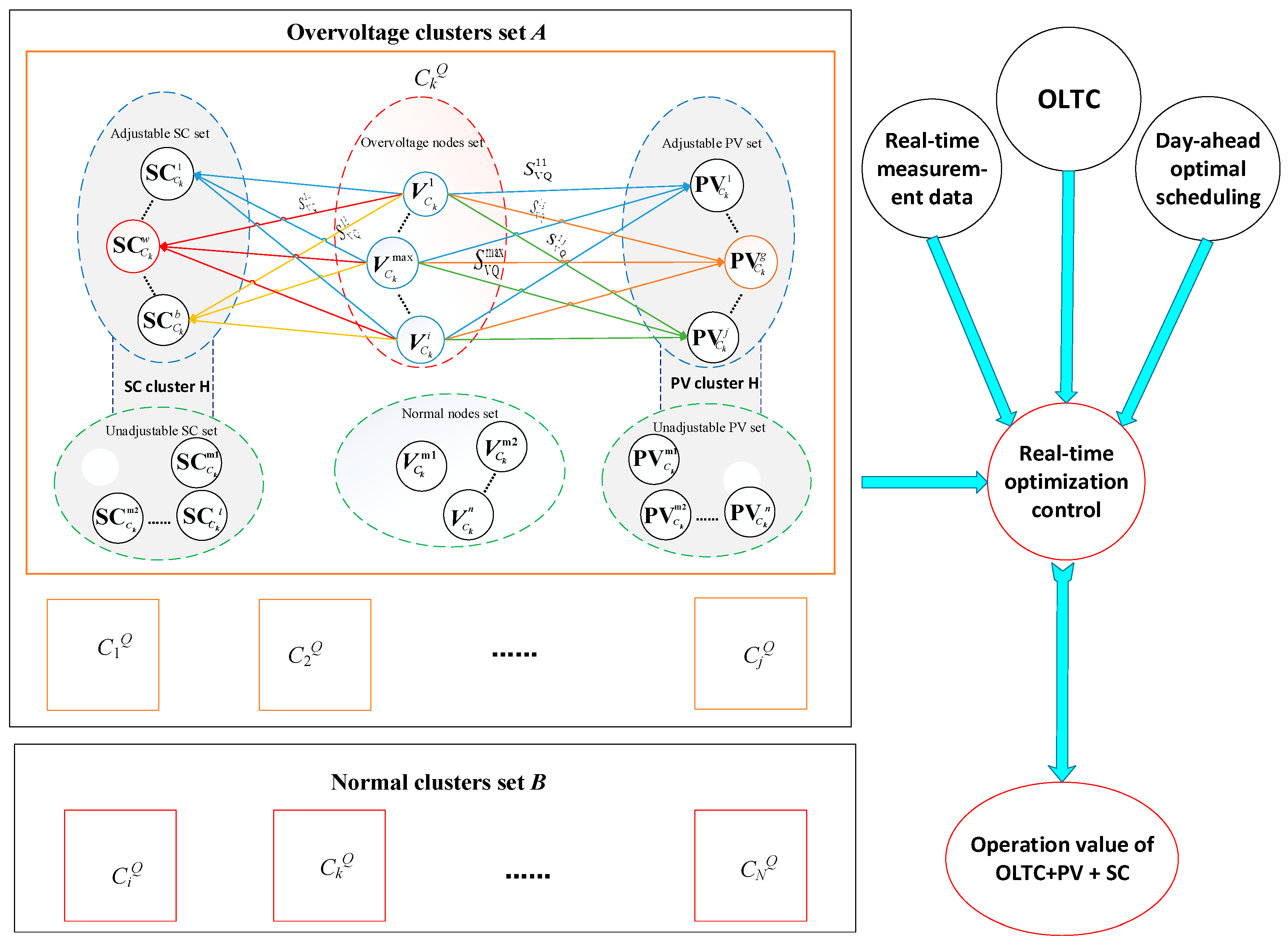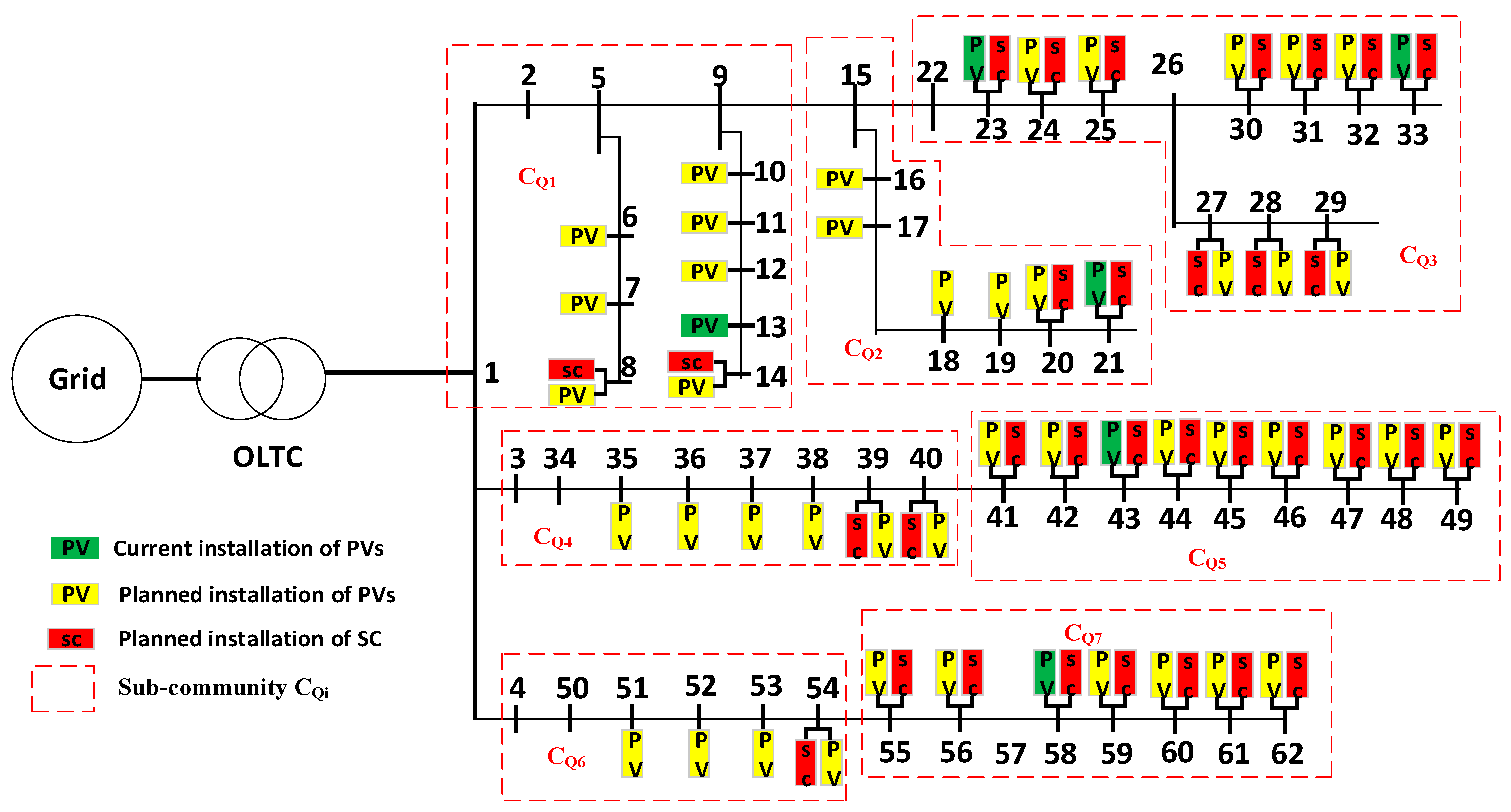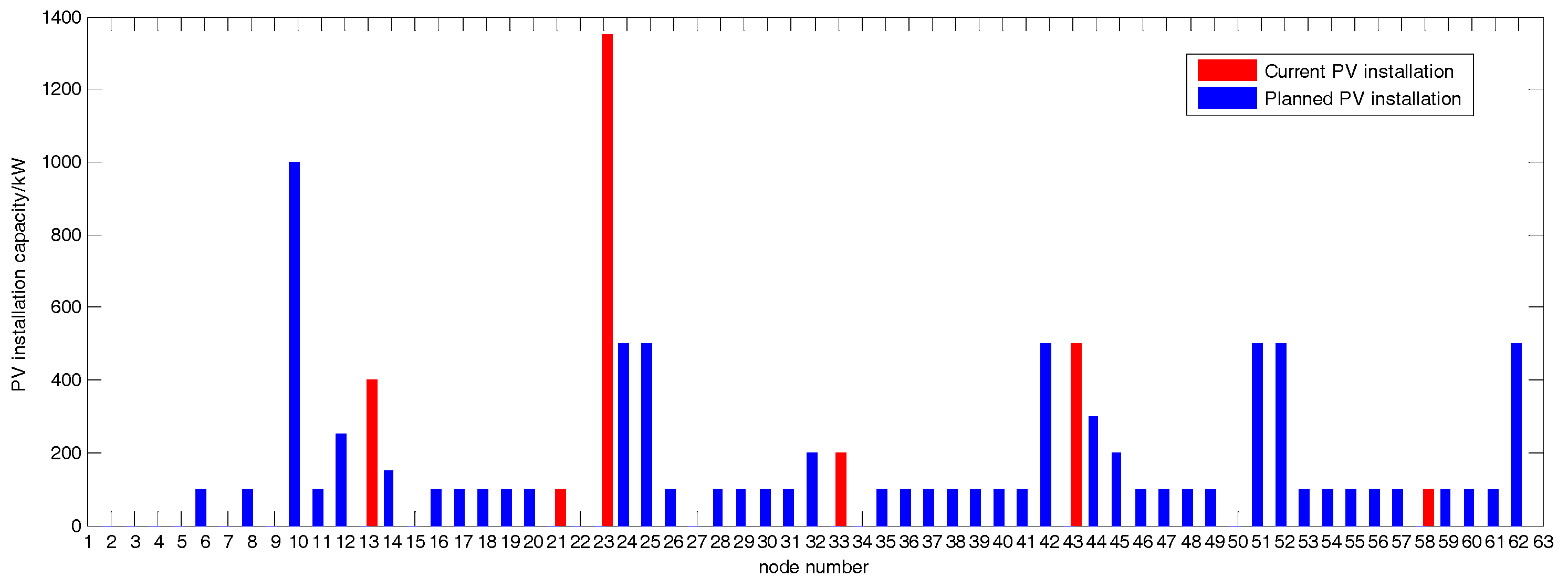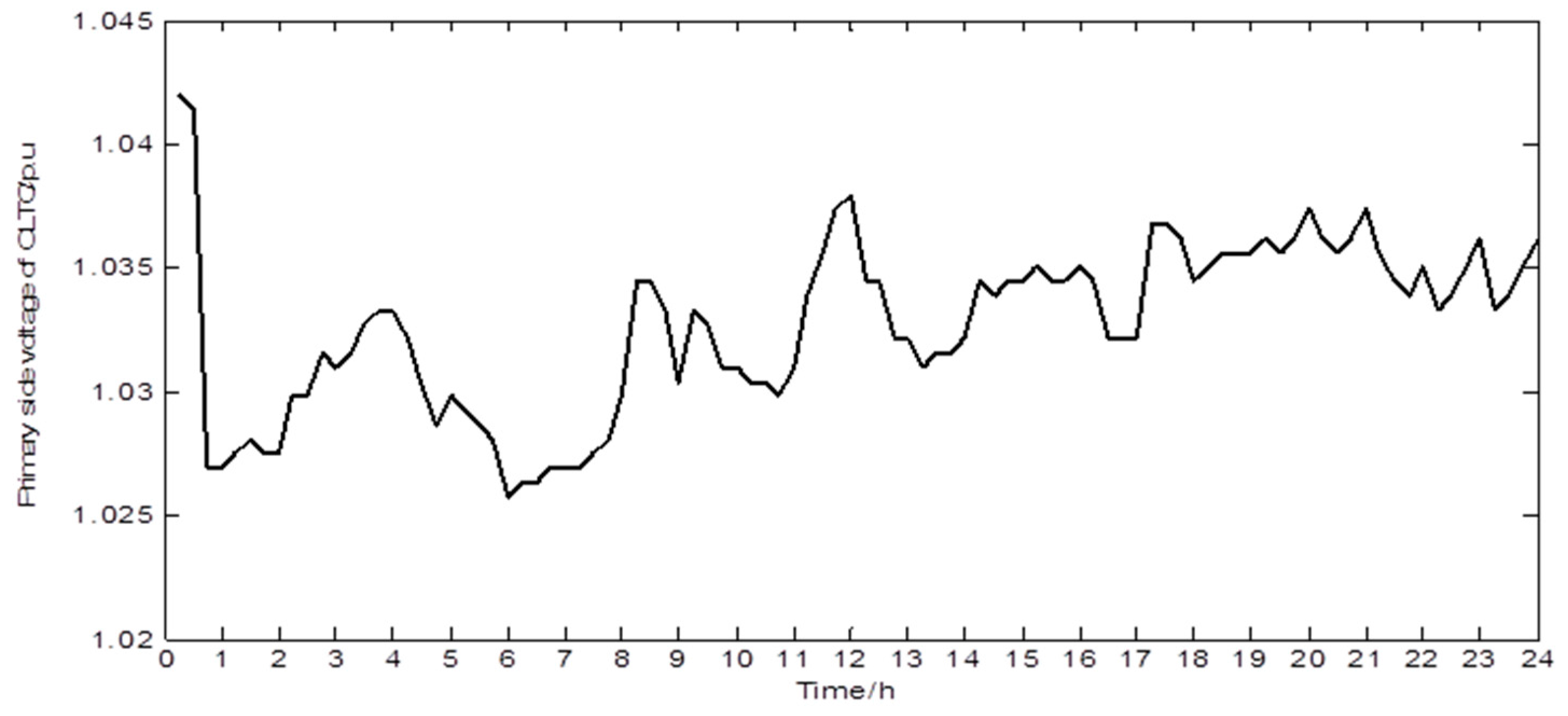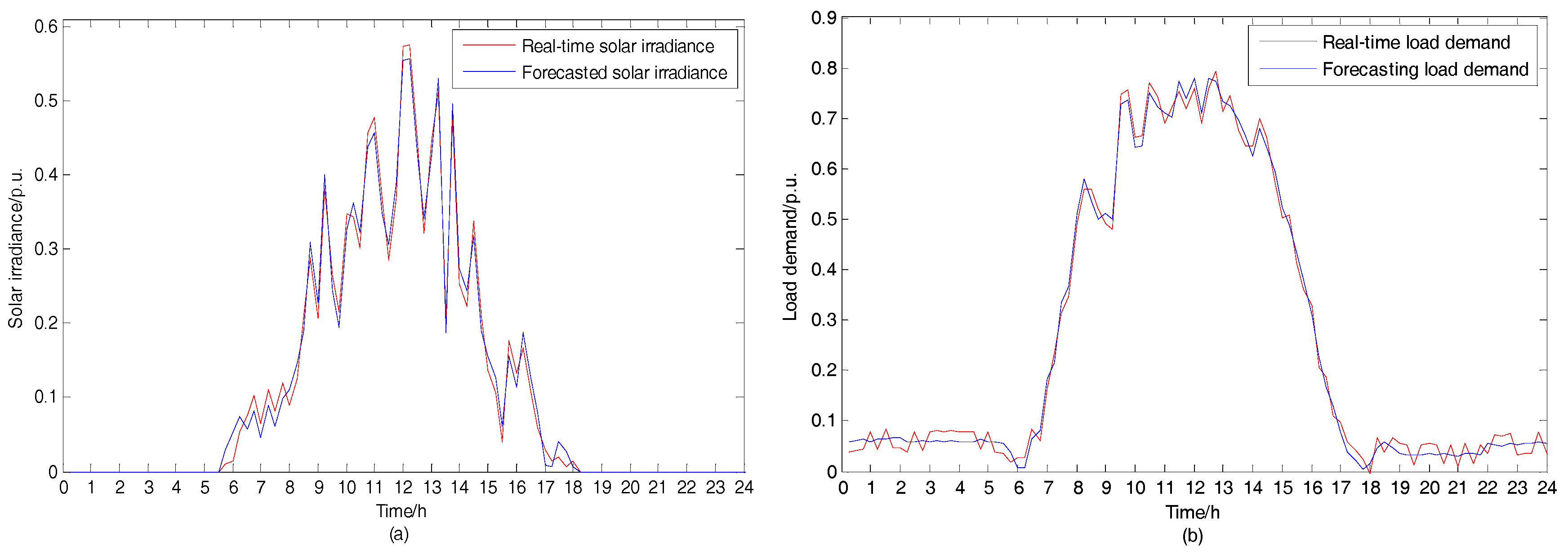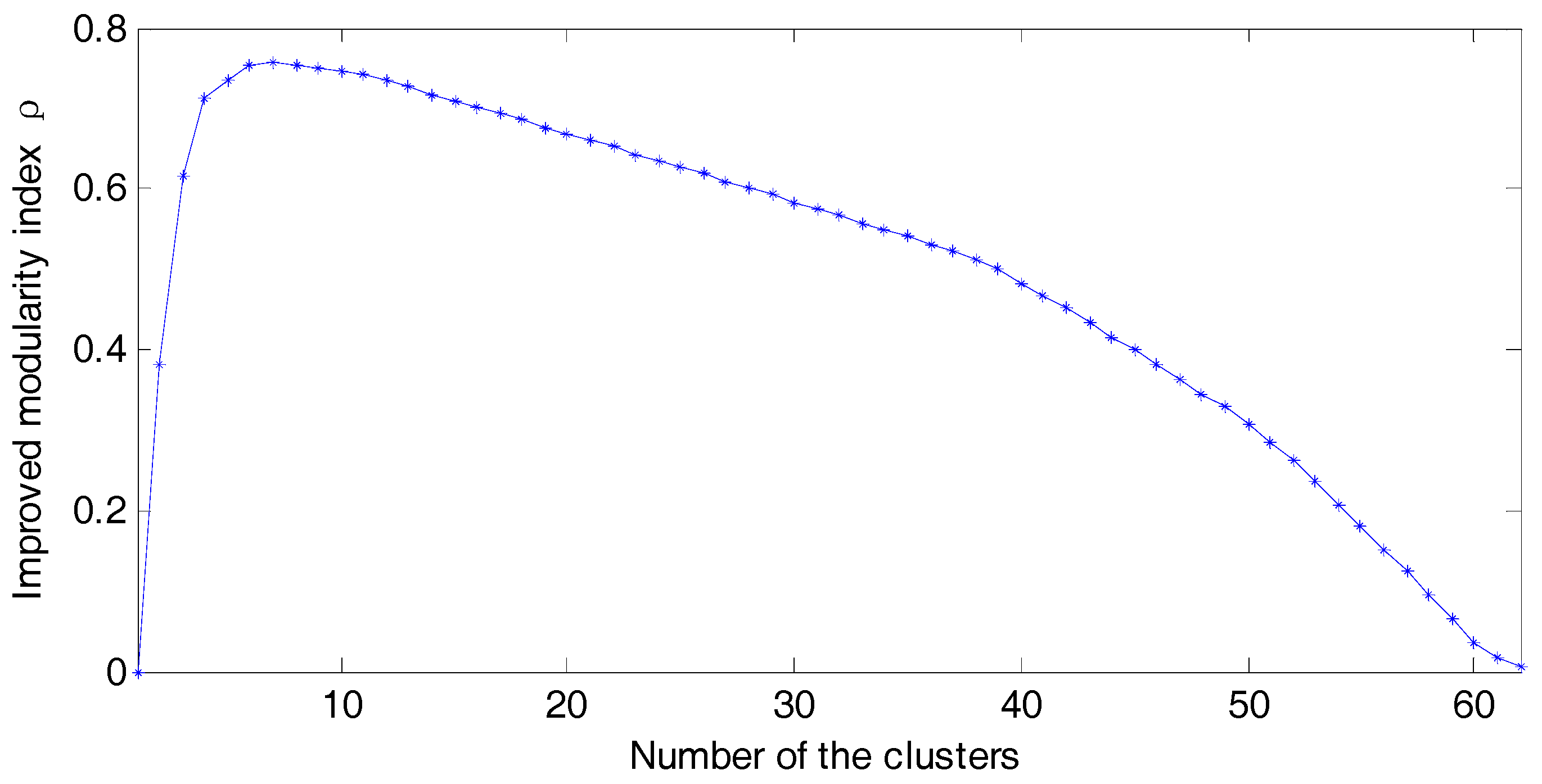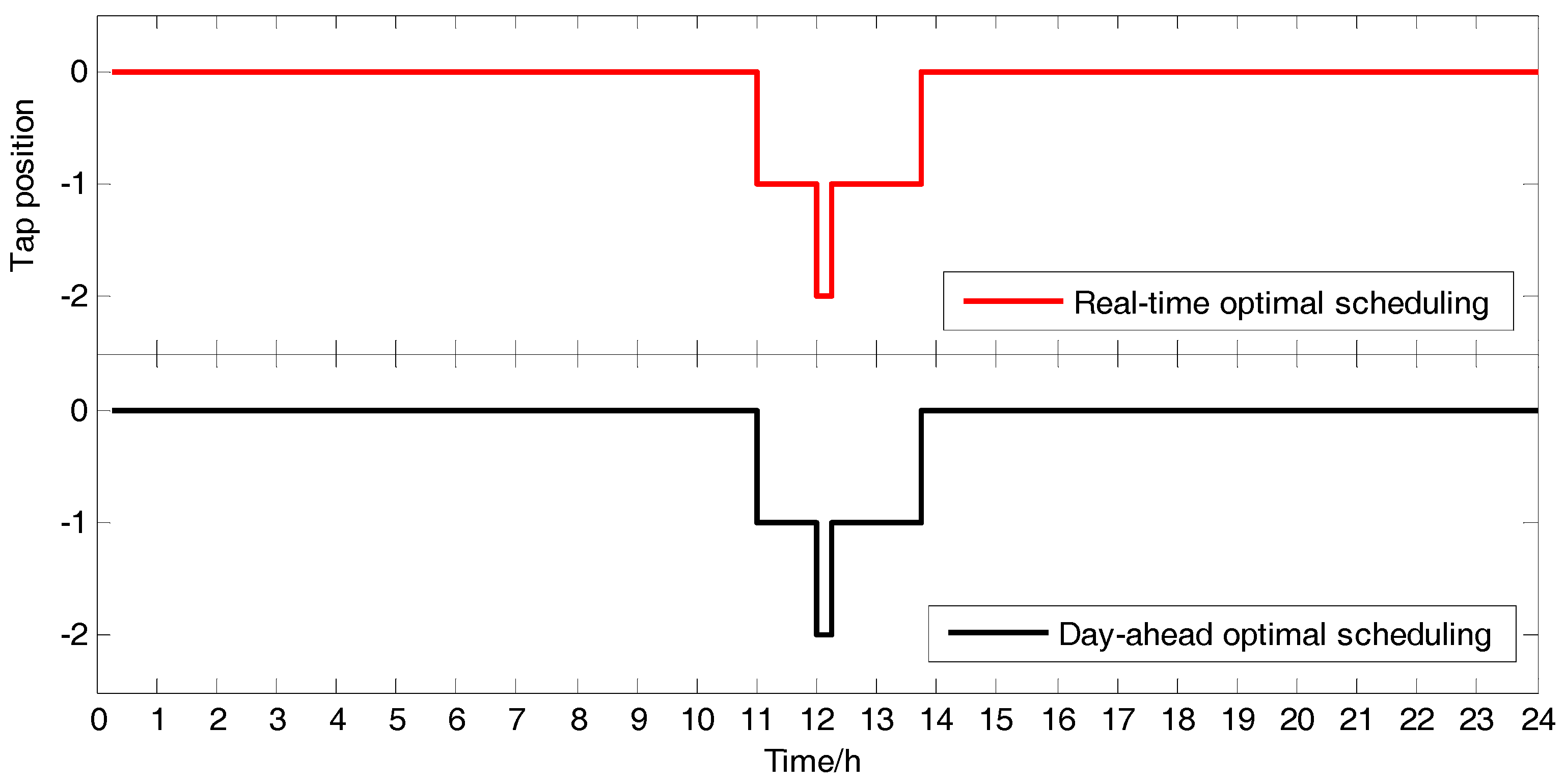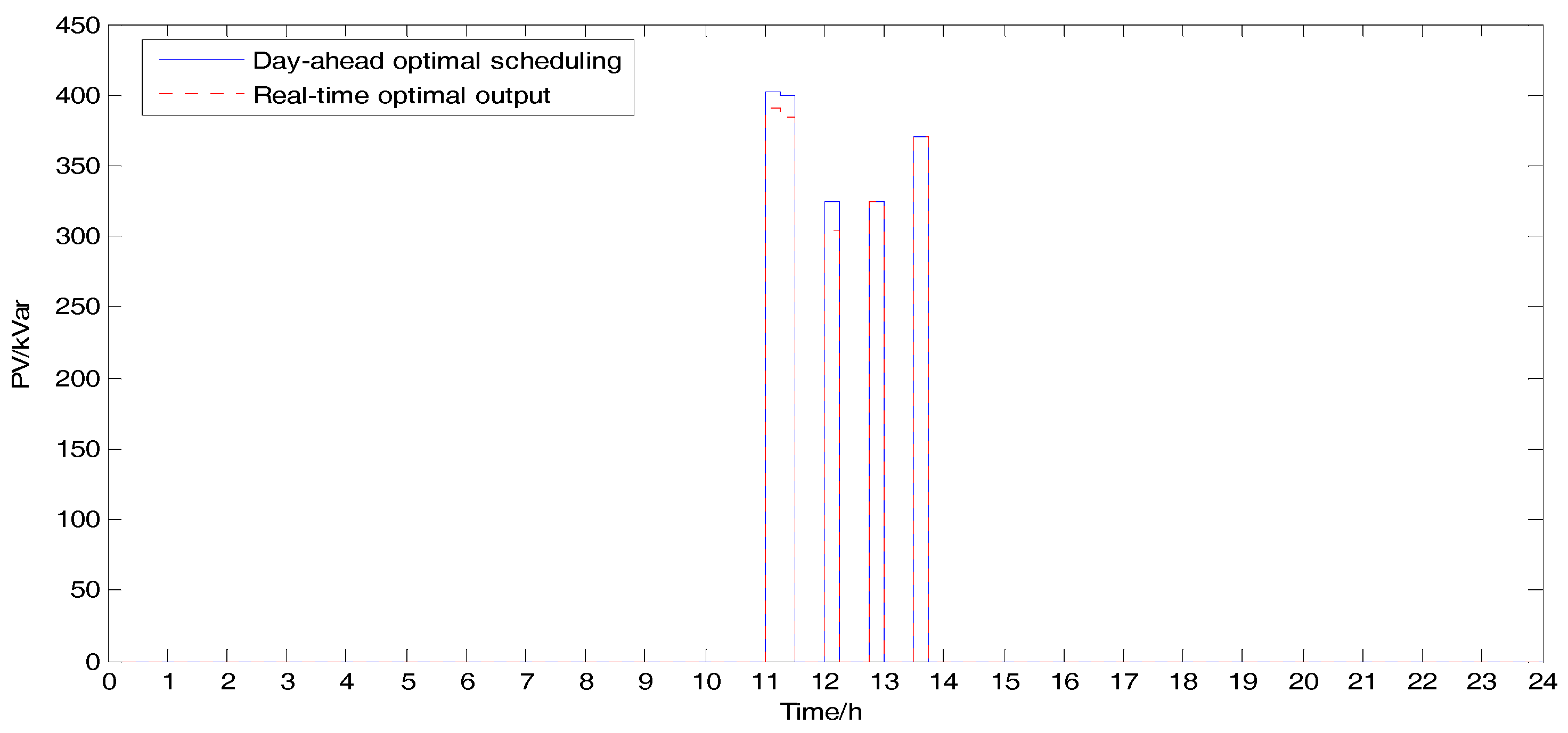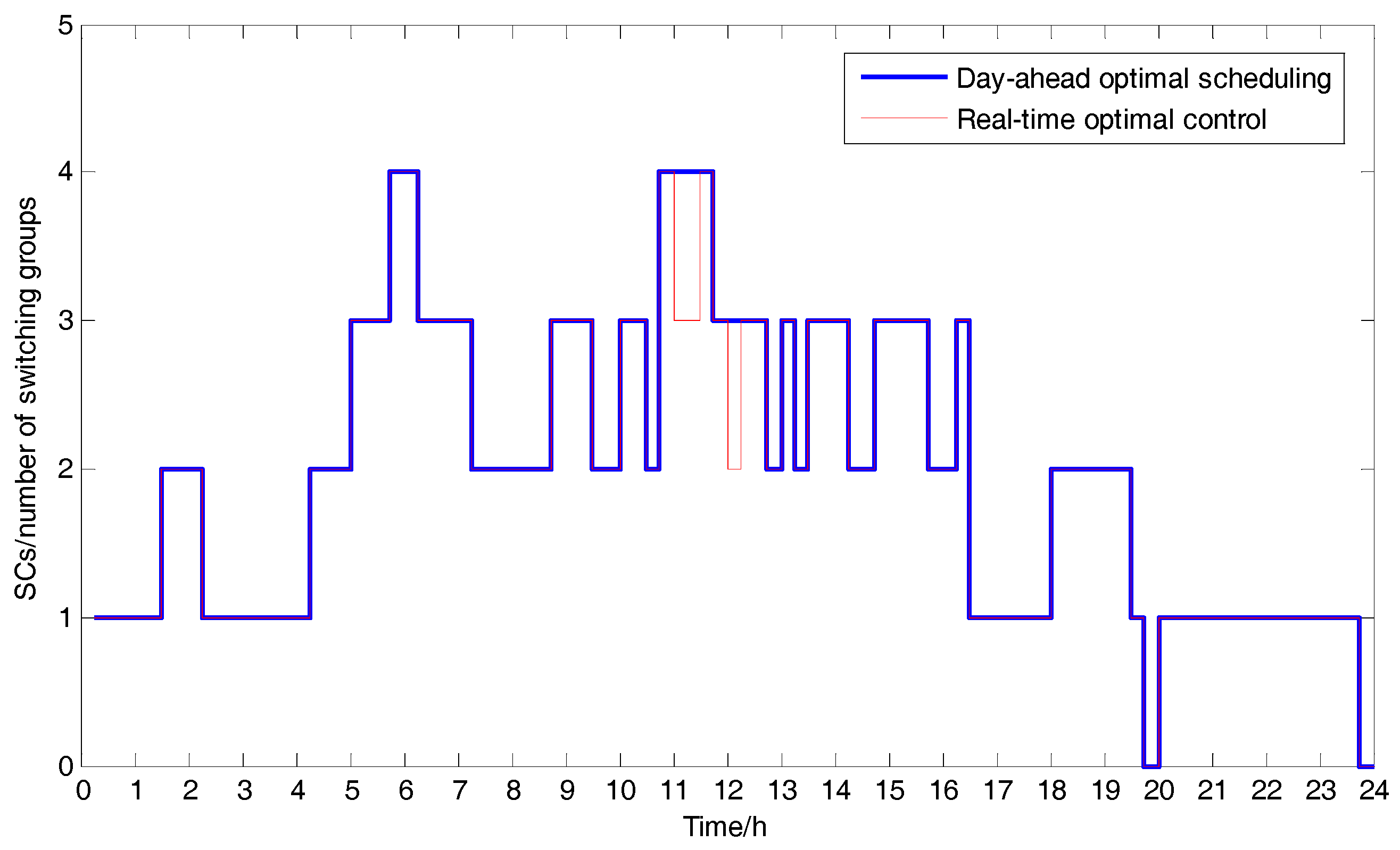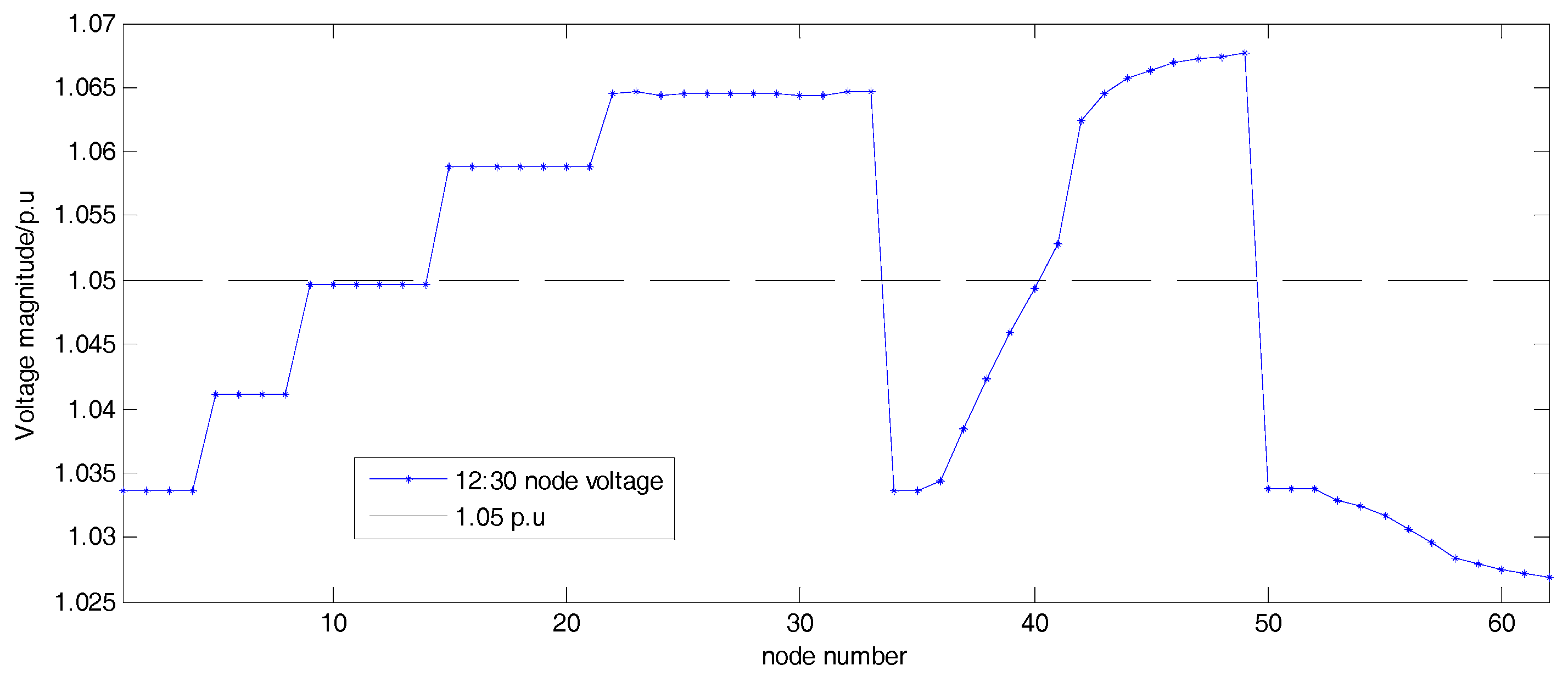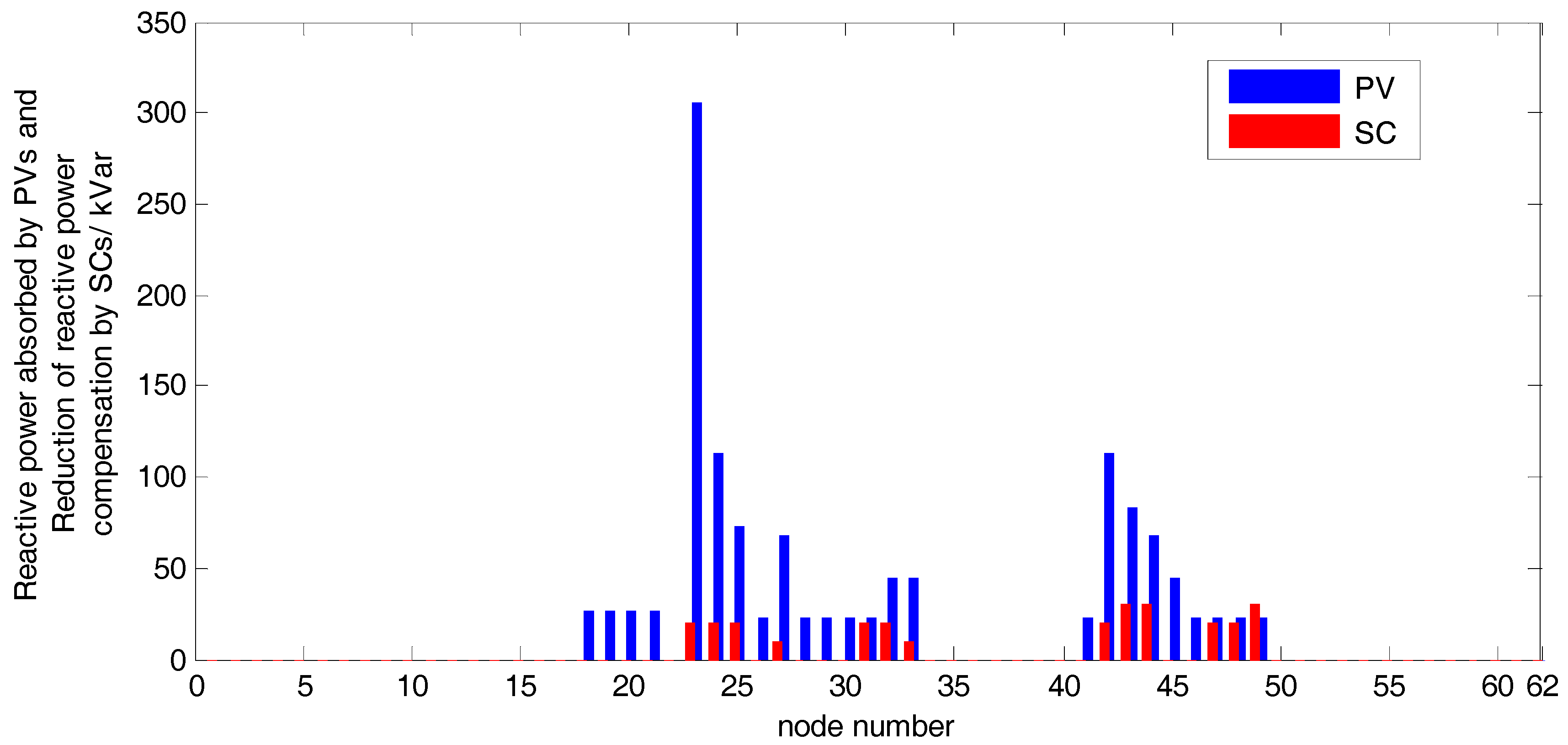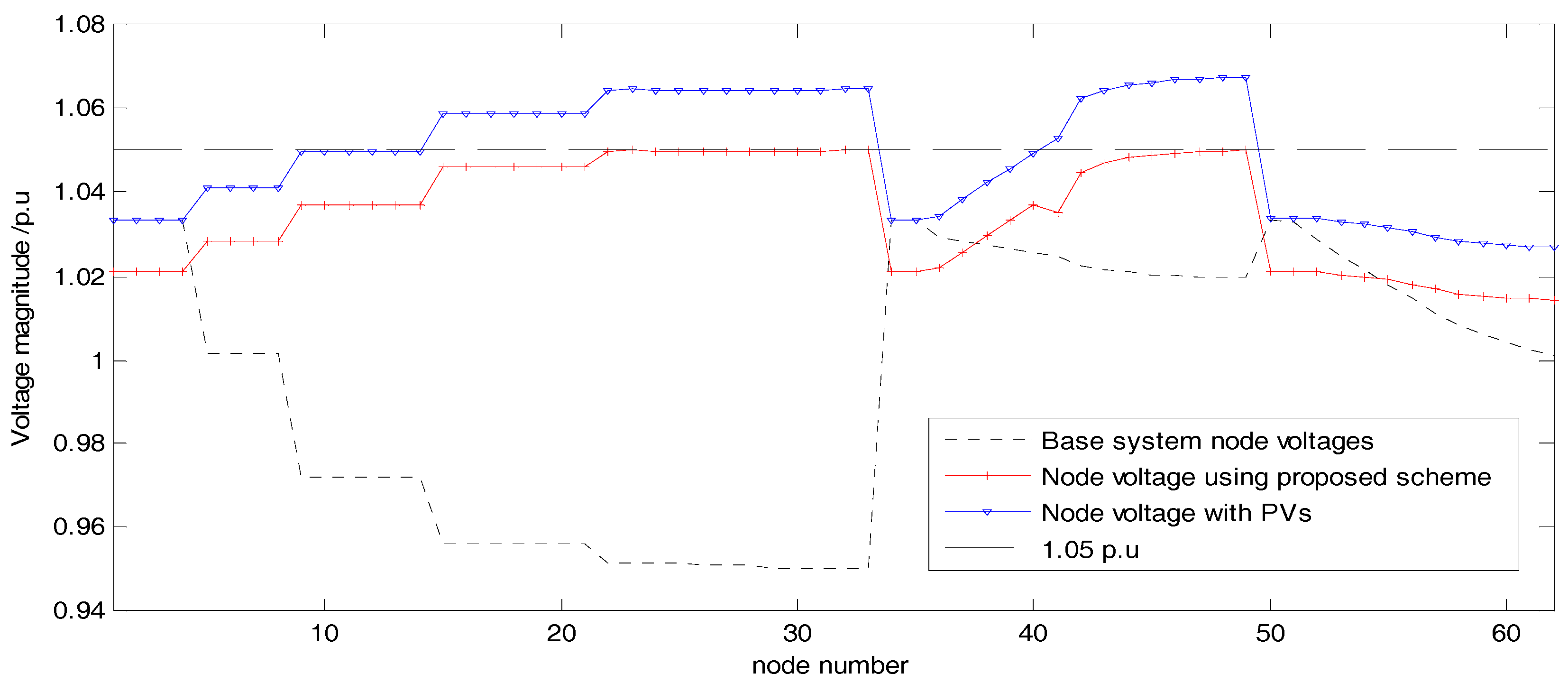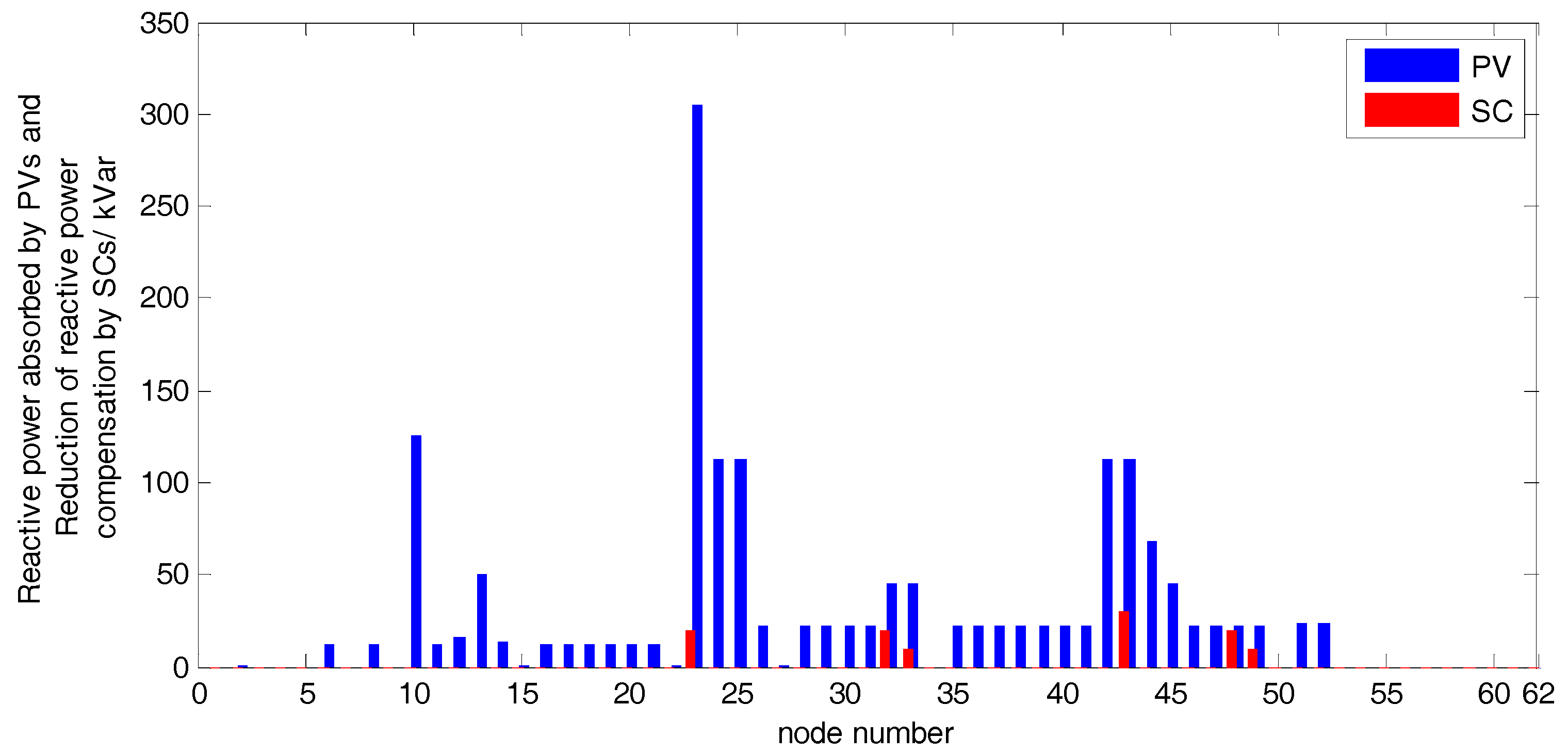5.1. Case Study System
A practical three-phase balanced 10 kV radial feeder located in Zhejiang Province, China, is utilized to verify the proposed approach. As shown in
Figure 4, there are 62 load nodes with a total nominal load of 26.32 MVA along the feeder. Each PV unit in the system is integrated into the feeder through a step-up transformer.
For the practical system, the capacity and location of the PVs are shown in
Table 1. No overvoltage issue has been reported during its past operation under this situation. According to the future PV installation plan, 8.3 MW PVs will be added to this feeder. The future PV installation capacity of each new PV unit together with the existing ones is shown in
Figure 5. To improve the PV-hosting capacity of the distribution network with high proportion of PVs, distributed SCs are selected as auxiliary voltage regulating equipment and installed along the feeder. The locations of distributed SCs are shown in
Figure 4; each SC access point is connected to five groups of SCs, and the capacity of each group is 10 kVar. In this paper, the tap changer of OLTC is set at ±8 taps with 0.625% voltage regulation per tap. The detailed line parameters are listed in
Table A1 of the
Appendix A, and the load parameters are listed in
Table A2 of the
Appendix A.
Given the detail of this distribution network, a corresponding simulation model is established using the OpenDSS (version 7.6.5.13) programme. The base voltage and the base power are set as 10 kV and 100 MVA, respectively. The day of 16 July 2014 with the strongest solar irradiance is selected to verify the feasibility and effectiveness of the proposed strategy. The voltage at the primary side of the OLTC among 16 July 2014is shown in
Figure 6. The forecast value and real-time value of solar irradiance (with respect to the reference irradiance of 1500 W/m
2) of 16 July 2014, as well as load demand, are shown in
Figure 7. The ambient temperature is set at 25 °C in the simulation studies. The operational power factor of each inverter ranges from −0.95 to 0.95. The actual PV generation efficiency of the distributed PVs is 78%.
5.3. Result of the Two-Level Voltage Control Method
According to the forecast of the PV output and load demand on 16 July 2014, the day-ahead optimal scheduling for the distribution network is obtained by the proposed method described in
Section 3 on 15 July 2014. In each control period of 16 July 2014, combining the day-ahead optimal scheduling, the real-time operation values of OLTC, as well as the PVs and distributed SCs in selected sub-networks (take the node 23 as an example), are modified according to the real-time measurement by the proposed method in
Section 4.
The tap operation given by the two-level voltage control method for LOTC on 16 July 2014 is shown in
Figure 9. It can be seen that the real-time tap operation in real-time voltage optimal control is exactly the same as the plan in the day-ahead optimal scheduling, and the real-time level (real-time voltage optimal control) can a minimum deviation from the day-ahead level (day-ahead optimal scheduling), which achieves the economic efficiency of OLTC operation. To illustrate that the proposed method can effectively reduce the number of tap-changes, the method constant set-point control (CSC) [
21] is selected as a comparative case. The comparison of OLTC tap-position on 16 July 2014 controlled by the proposed method and CSC are shown in
Figure 10.
In
Figure 10, the tap-position is changed eight times per day by the CSC, which is the critical value allowed for the constraints. If the greater voltage deviation occurs due to weather conditions in one day, it may cause the total number of tap-changes to exceed the allowable value and shorten the OLTC service life. However, in the proposed method, the OLTC tap-position only changes four times, which effectively reduces the number of tap-changes. Moreover, the total number of tap-changes per day is much less than the maximum allowable value. Thus, the optimization process takes the coordination of the control response time into account, which can regulate the voltage effectively and reduce the number of tap-changes, thereby prolonging the OLTC service life.
The reactive power absorbed by the PV inverter of node 23 in day-ahead optimal scheduling and the final real-time voltage optimal control on 16 July 2014 are shown in
Figure 11. In the proposed method, the PV inverters absorbed the reactive power during the periods 11:00~11:30, 12:00~12:15, 12:45~13:00 and 13:30~13:45. Because at these periods, due to the sufficient solar irradiance, the PV output rises immensely, causing overvoltage in the distribution network. In
Figure 11, the reactive power absorbed by PV inverters in day-ahead optimal scheduling is larger than that in real-time optimal voltage control during the periods 11:00~11:30 and 12:00~12:15, but the reactive power absorbed by PV inverters in two methods are the same during the periods 12:45~13:00 and 13:30~13:45. Because, during the periods 11:00~11:30 and 12:00~12:15, the forecast value of PVs was larger than the real-time value, the PV output based on the forecasted value is more than that in real-time; if the PV inverters operate by the day-ahead optimal scheduling, the reactive power capacity of PV the inverters is insufficient in real-time, and the voltage cannot be adjusted to a safe operating range. However, during the periods 12:45~13:00 and 13:30~13:45, the forecasted value of the PVs is smaller than the real-time value, and the reactive power capacity of the PV inverters is sufficient in real-time, which will not deviate from the day-ahead optimal scheduling. Therefore, during the periods 12:45~13:00 and 13:30~13:45, the reactive power absorbed by PV inverters in the day-ahead optimal scheduling is same as that in real-time voltage optimal voltage control. The operation of SCs in node 23 under the day-ahead optimal scheduling and the final real-time voltage optimal control on 16 July 2014 are shown in
Figure 12. The difference occurs between the two curves during periods 11:00~11:30 and 12:00~12:15. Because the PV output based on the forecasted value is more than that in real-time during these periods, the reactive power capacity of the PV inverters is insufficient in real-time, and thus, some SCs must quit operation.
5.4. Real-Time Voltage Optimal Voltage Control
To illustrate that the real-time optimal voltage control can effectively correct the day-ahead optimal scheduling through modifications and efficiently adjust the node voltage to a safe operating range, the worst voltage of the distribution network at 12:00 on 16 July 2014 is selected to be analysed in this paper. Without any voltage regulation measures, the node voltage at 12:00 on 16 July 2014 is shown in
Figure 13. As the solar irradiance reaches the maximum value at 12:00, a power reversal occurs in the distribution network, which causes an increased voltage at each node; the maximum node voltage reaches 1.068 p.u.
Figure 4 and
Figure 13 show that the sub-network set with overvoltage nodes is M{
CQ2,
CQ3,
CQ5}. The node voltages in the other sub-networks (
CQ1,
CQ4,
CQ6 and
CQ7) are operating within the safe range. According to the proposed method, the sub-networks
CQ2,
CQ3,
CQ5 are chosen to perform the real-time voltage optimal voltage control. After the voltage regulation for all the selected sub-networks, the reactive power absorbed by PV inverters and reduction of the reactive power compensation due to the SC termination in each node are shown
Figure 14. From
Figure 4 and
Figure 13, overvoltage does not exist in sub-networks
CQ1,
CQ4,
CQ6 and
CQ7. Thus, the PV inverters and distributed SCs in
CQ1,
CQ4,
CQ6 and
CQ7 continue to operate by the day-ahead optimal scheduling, but because of the existing overvoltage in sub-networks
CQ2,
CQ3,
CQ5, the PV inverters and distributed SCs in these sub-networks must operate by the real-time voltage optimal voltage control.
The voltage profile of the feeder after control by the proposed method is shown in
Figure 15. The black dotted line (namely, the base case) represents the voltage profile of the feeder when no PVs access the feeder. The blue line represents the voltage profile of the feeder when all the PVs access the feeder. The red line represents the voltage profile using the proposed voltage control scheme. As shown in this figure, the proposed method can effectively regulate the voltages of the feeder within the acceptable range.
To further illustrate the advantages of the proposed method, this paper sets up two comparison cases: first, at the real-time level, it still adapts the proposed real-time voltage optimal voltage control method, but the OLTC does not participate in the voltage control; second, in the two-level voltage control, day-ahead optimal scheduling and the real-time optimal voltage control are conducted based on centralized control (non-partition). The voltage profile under the three control methods is shown in
Figure 16.
Table 2 shows the difference between the first comparison case and the proposed method. Whereas the OLTC does not participate in the voltage regulation, the operation cost of the feeder is much higher. In addition,
Figure 16 illustrates that the voltage is not regulated to the specified range under the first comparison method. Therefore, the comparison results demonstrate that the real-time voltage optimal voltage control method at the real-time level, which only relies on zonal control but without the OLTC, cannot complete the voltage regulation for the feeder. However, the real-time voltage optimal voltage control method at the real-time level proposed in this paper not only can effectively regulate the node voltage to the specified range but can also greatly increase the PV hosting capacity for the feeders with high proportion of PVs. In the second comparison case, the two-level voltage control scheme is formulated based on centralized control, which can be regarded as all nodes being assigned to one sub-network. In
Figure 16, both of the two-level voltage control schemes based on centralized control and zonal control can regulate the voltage to the specified range, and the voltage profile under the two schemes have the same trend and a similar amplitude.
This finding demonstrates that the proposed scheme has nearly the same control effect as does the centralized control scheme; thus, zonal control is feasible. The reactive power regulated by the PVs and distributed SCs in the second comparison case is shown in
Figure 17.
Figure 14 and
Figure 17 show that, using the centralized control method, the quantity of PVs involved in the voltage regulation is much greater than that in the zonal control method.
Table 3 shows the difference between the second comparison case and the proposed method in this paper.
From the table, with the centralized control method, the total reactive power absorbed by the PVs is 1674 kVar, 11 groups of distributed SCs quit operation, and the system operating cost is 169.41/$. However, with the zonal control method, the total reactive power absorbed by the PVs is 1290 kVar, 27 groups of distributed SCs quit operation, and the system operating cost is 176.15/$. In comparison, the centralized control method is more economical than the zonal control method because the centralized control method provides global optimization for the feeder, but the zonal control method optimized in the selected sub-networks provides local optimization. As shown, the operational costs of the two methods are quite close. Considering the growing proportion of PVs, the cost of zonal control will be further reduced. Therefore, it is acceptable in practical engineering applications.
In voltage control, the magnitude of the voltage is an important index to evaluate the quality of the control. However, with the high proportion of PVs accessing distribution networks, the number of control nodes increases rapidly, and the output of the PV units can be greatly affected by the weather conditions. Considering the requirements of real-time control, the control response time is an important index to evaluate the quality of control.
Table 3 shows the control response time under centralized control method l and the zonal control method, and the control response time is obtained in the MATLAB (version 2014a) simulation environment.
Table 3 lists that the control response time under the centralized control method is 30.61 s. However, the control time under the zonal control method is 4.23 s. The main reason is that, when the node voltage is regulated by the centralized control method, all the PVs and SCs are involved in the optimization process, which greatly increases the optimization complexity. By contrast, under the zonal control method, the network partition can divide the nodes into sub-networks, which can reduce the optimization scale for the PVs and distributed SCs from the entire distribution network to the selected sub-networks. When the voltage regulation is performed within the selected sub-networks, the optimization is achieved only among the PVs and SCs within the selected sub-networks, and there is no need to consider the impact of other sub-networks. Consequently, this method can greatly reduce the number of control nodes and simplify the optimization process. With the increasing proportion of PVs, the advantage of the proposed zonal control method will be more obviously promising over the control response time. Thus, compared with centralized control method, the proposed method will be more suitable for voltage control in future distribution network with high proportion of PVs.
The above-described theoretical and empirical analysis reveals that the scheme proposed in this paper can reduce the number of control nodes, simplify the optimization process, and regulate the voltage of the distribution network to the specified range, rapidly and economically; this advantage will be increasingly more obvious as the number of control nodes increases. In addition, the proposed scheme can optimize the number of OLTC tap-changes, prolong the OLTC service life, and increase the PV-hosting capacity of distribution networks with high proportion of PVs. Therefore, the proposed scheme can satisfy the actual engineering requirements and can be applied to the voltage regulation of future distribution networks with high proportion of PVs.
